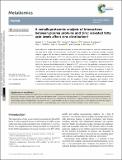Files in this item
A metalloproteomic analysis of interactions between plasma proteins and zinc : elevated fatty acid levels affect zinc distribution
Item metadata
| dc.contributor.author | Coverdale, James P. C. | |
| dc.contributor.author | Barnett, James P. | |
| dc.contributor.author | Adamu, Adamu H. | |
| dc.contributor.author | Griffiths, Ellie J. | |
| dc.contributor.author | Stewart, Alan James | |
| dc.contributor.author | Blindauer, Claudia A. | |
| dc.date.accessioned | 2019-10-17T11:30:06Z | |
| dc.date.available | 2019-10-17T11:30:06Z | |
| dc.date.issued | 2019-11-01 | |
| dc.identifier | 261146765 | |
| dc.identifier | f99a958f-5494-4b35-93f0-5efa98b77c84 | |
| dc.identifier | 85074962724 | |
| dc.identifier | 000498707800014 | |
| dc.identifier.citation | Coverdale , J P C , Barnett , J P , Adamu , A H , Griffiths , E J , Stewart , A J & Blindauer , C A 2019 , ' A metalloproteomic analysis of interactions between plasma proteins and zinc : elevated fatty acid levels affect zinc distribution ' , Metallomics , vol. 11 , no. 11 , pp. 1805-1819 . https://doi.org/10.1039/C9MT00177H | en |
| dc.identifier.issn | 1756-5901 | |
| dc.identifier.other | ORCID: /0000-0003-4580-1840/work/63380887 | |
| dc.identifier.uri | https://hdl.handle.net/10023/18697 | |
| dc.description | Funding: Leverhulme Trust (grant ref. RPG-2017-214) and BBSRC (grant ref. BB/J006467/1). | en |
| dc.description.abstract | Serum albumin is a highly abundant plasma protein associated with the transport of metal ions, pharmaceuticals, fatty acids and a variety of small molecules in the blood. Once thought of as a molecular ‘sponge’, mounting evidence suggests that the albumin-facilitated transport of chemically diverse entities is not independent. One such example is the transport of Zn2+ ions and non-esterified ‘free’ fatty acids (FFAs) by albumin, both of which bind at high affinity sites located in close proximity. Our previous research suggests that their transport in blood plasma is linked via an allosteric mechanism on serum albumin. In direct competition, albumin-bound FFAs significantly decrease the binding capacity of albumin for Zn2+, with one of the predicted consequences being a change in plasma/serum zinc speciation. Using liquid chromatography (LC), ICP-MS and fluorescence assays, our work provides a quantitative assessment of this phenomenon, and finds that in the presence of high FFA concentrations encountered in various physiological conditions, a significant proportion of albumin-bound Zn2+ is re-distributed amongst plasma/serum proteins. Using peptide mass fingerprinting and immunodetection, we identify candidate acceptor proteins for Zn2+ liberated from albumin. These include histidine-rich glycoprotein (HRG), a multifunctional protein associated with the regulation of blood coagulation, and members of the complement system involved in the innate immune response. Our findings highlight how FFA-mediated changes in extracellular metal speciation might contribute to the progression of certain pathological conditions. | |
| dc.format.extent | 15 | |
| dc.format.extent | 3305915 | |
| dc.language.iso | eng | |
| dc.relation.ispartof | Metallomics | en |
| dc.subject | RB Pathology | en |
| dc.subject | RC Internal medicine | en |
| dc.subject | RM Therapeutics. Pharmacology | en |
| dc.subject | NDAS | en |
| dc.subject.lcc | RB | en |
| dc.subject.lcc | RC | en |
| dc.subject.lcc | RM | en |
| dc.title | A metalloproteomic analysis of interactions between plasma proteins and zinc : elevated fatty acid levels affect zinc distribution | en |
| dc.type | Journal article | en |
| dc.contributor.sponsor | The Leverhulme Trust | en |
| dc.contributor.sponsor | BBSRC | en |
| dc.contributor.institution | University of St Andrews. School of Medicine | en |
| dc.contributor.institution | University of St Andrews. Sir James Mackenzie Institute for Early Diagnosis | en |
| dc.contributor.institution | University of St Andrews. Institute of Behavioural and Neural Sciences | en |
| dc.contributor.institution | University of St Andrews. Biomedical Sciences Research Complex | en |
| dc.contributor.institution | University of St Andrews. Cellular Medicine Division | en |
| dc.identifier.doi | 10.1039/C9MT00177H | |
| dc.description.status | Peer reviewed | en |
| dc.identifier.grantnumber | RPG-2017-214 | en |
| dc.identifier.grantnumber | BB/J006467/1 | en |
This item appears in the following Collection(s)
Items in the St Andrews Research Repository are protected by copyright, with all rights reserved, unless otherwise indicated.

